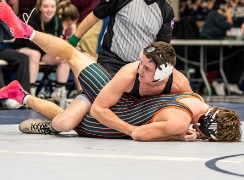Big Bill Hardin and the colony
From the Mountains

Hardin descended from a family of French Protestants who fled France for Canada to escape religious persecution. The cold Canadian climate wasn’t agreeable to them so the three brothers migrated to Virginia, South Carolina and Kentucky.
Colonel William Hardin was one of the brothers. He and his party floated down the Ohio River in 1778, stopping where Louisville is now situated. They remained there for a short time before proceeding a little further down the Ohio River and up Sinking Creek.
A threatening party of Indians appeared soon after their landing at the Falls south of what is now Louisville. Hardin’s men were outnumbered so they attempted to evade them. They decided to abandon the boat and proceed overland to Hine’s Fort, where Elizabethtown, Kentucky is now situated. When they did the Indians continued to follow.
They traveled all night, reaching a large spring the following morning where the men stopped for a short rest and drink. During this respite the Indians overtook them and a fight ensued. Hardin’s main interest was to evade the conflict so they fought to extricate themselves from the fight. One of their number, Mr. St. Clair, was killed but Big Bill and the rest were more fortunate and escaped, continuing toward Hines Fort.
Hardin found Hines Fort to be an acceptable site for his colony. He returned to get his family and others with plans to locate in Kentucky. He returned with twelve families in the spring of 1779 and they immediately began construction of a frontier fort with stockade walls, watch towers and several cabins. They also prepared for spring planting.
After several weeks a small party of Indians discovered the fort while out hunting. They hurried back to their village to notify their tribesmen. A war party, as purposeful as hornets was soon on their way to destroy the fledgling fort. Upon their arrival the Indians rushed the fort from all sides.
Hardin, a supreme Indian fighter, saved the day. Fearless, he was everywhere doing whatever he thought was needed to secure victory including assisting and encouraging his men. The Indians suffered heavy losses and fell back to the woods to seek shelter. During the night they gathered their dead where possible.
Hardin knew their next attack would be forthcoming and likely more terrible than the first. He prepared the settlers for another battle. Although the Indians lost many braves, they attacked the following morning more determined than before. They charged the fort with heavy fire. The pioneers met them with guns, knives and tomahawks as the Indians attempted to enter the stockade.
After the the Indians fired their rifles, they had no time to reload. Their rifles became bludgeoning instruments for them.
The pioneer women helped greatly during the battle. After the men fired their rifle, the women would grab and reload it and hand it back ready for firing again. The Indian had no such luxury. The women learned to reload rifles during that difficult time in our history. This was likely the turning point that overcame the onslaught. The women helped saved the day and their lives.
The second battle ended the attempts by the Indians to take the fort but they continued waiting and watching to do damage when an opportunity arose. They lay in wait and took potshots at residents of the fort from hidden locations. Long periods of time would pass without even seeing a sign of an Indian and then a resident would be killed or wounded when least expected. A search of the nearby woods would reveal nothing. The Indians seemed to blend into the landscape.
The men had to leave the fort at times to chop wood or to cut away obstructions that offered the Indians a place to hide. On a day after a shot nearly hit one of his men who was cutting wood outside the fort Big Bill decided on a trick to get rid of some of the Indians who were making life so difficult for them. Be sure and read the conclusion next week to see if his plan works.
Copyright 2012 Jadon Gibson. Next week Big Bill Col. Hardin also learns that an Indian village is being built nearby. It would present a large threat to their safety and well-being. Jadon Gibson is a freelance writer from Harrogate. His writings are both historic and nostalgic in nature. Thanks to Lincoln Memorial University, Alice Lloyd College and the Museum of Appalachia.

